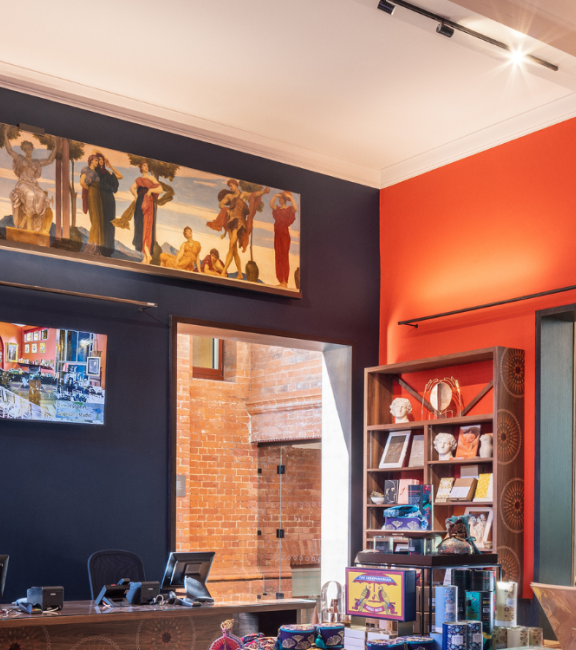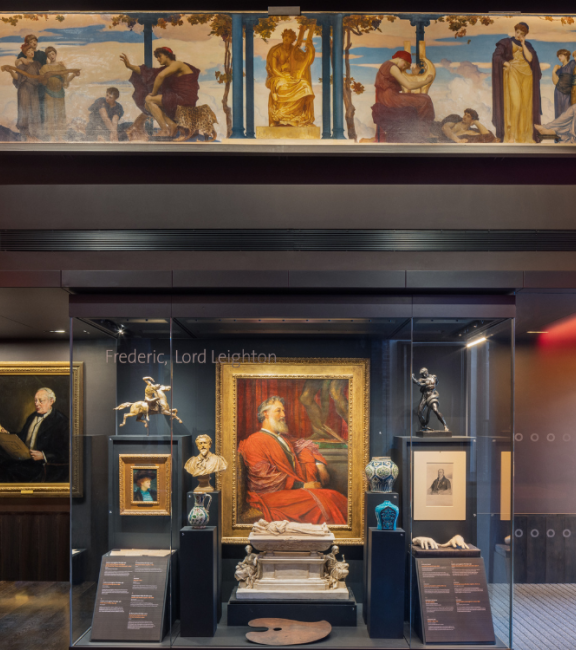Leighton’s Music and The Dance friezes
Leighton's 10 metre wide paintings are now on display in the new reception
Part of the Leighton House collection since the 1970s, Frederic Leighton’s decorative friezes Music and The Dance, have recently been awoken from years in storage.
Having previously had no capacity for their display within the historic house due to their substantial scale of over 10 metres wide, these sweeping works have now found a permanent home welcoming visitors to the museum’s new reception space, following the completion of the ambitious redevelopment, Hidden Gem to National Treasure.


The James Stuart Hodgson commission, 1 South Audley Street
Both works were originally created by Leighton as a commission from banker James Stuart Hodgson (1827-99). Hodgson was passionate about art, joining the Hogarth Club in 1859 where he met artists and architects including Rossetti, William Holman Hunt, William Blake Richmond and Leighton. Hodgson went on to become a life-long friend and patron to Leighton, collecting at least eighteen of his works over a forty year period.
In 1878, Hodgson commissioned the architect Frederick Pepys Cockerell (1833-1878) to build him a grand new London townhouse at 1 South Audley Street in Mayfair. Later that year, Cockerell died unexpectedly. The completion of the ‘Queen Anne’ style townhouse fell to the combined the talents of several celebrated architects, artists and designers of the Victorian age, including Leighton House architect, George Aitchison, who designed the principal interiors, and Walter Crane, who contributed designs for six gold mosaic panels – as he had done in the Arab Hall at Leighton House.
Hodgson commissioned Leighton’s Music and The Dance friezes to decorate the new drawing room of 1 South Audley Street. Despite eventually committing to the commission, Leighton was originally reluctant to accept it and struggled to balance their completion against other projects, writing to Hodgson in an undated letter:
I write to throw myself on your mercy - I have no excuse - a promise is a promise and you can keep me to it if you desire - I can by dropping everything else do your frieze this summer - it is designed and begun on canvas
Both works were eventually completed and installed by 1885.
Classicism and Aestheticism
Depicting a series of classical figures against a sun-suffused sky, the frieze format was likely influenced by Classical sculpture, particularly the Parthenon frieze, a partial plaster copy of which still hangs today in Leighton’s Studio. It was a format which Leighton explored throughout his career, from Cimabue’s Madonna is Carried in Procession (1853-55, Royal Collection Trust), to The Syracusan Bride (1866, private collection), The Daphnephoria (1876, Lady Lever Art Gallery), and Captive Andromache (c.1888, Manchester Art Gallery).
Created in the early 1880s at the height of the Aesthetic movement, which prioritised formal beauty over narrative content, the figures are carefully posed to create a harmonious and elegant composition, with the themes of music and dance performing a secondary function.
The Dance, 1881-1883
Leighton began his work with The Dance which he exhibited at the Royal Academy in 1883. The composition does not illustrate a particular event or story but draws on a generalised classical inspiration. A central silver statue with arms raised represents Dance and at either side figures move to the accompaniment of tambourines.
Music, 1883-5
Positioned opposite The Dance across the room, Leighton mirrored the format of the earlier work, replacing the central silver muse with a golden statue playing a lyre as the personification of Music. On the left, three children sing from a shared scroll, and to the right a group gathers to listen to a female figure playing a golden lyre.
Leighton’s drawing studies
As with all of Leighton’s major works, he produced numerous preliminary studies for the two friezes, from drapery studies to compositional drawings, many of which remain within the museums collection.
More highly finished than was typical, the below drawing of the entire composition for Music (c.1884) may have been made to give Hodgson an impression of the work as he patiently waited more than two years for the finished canvas.
Return to Leighton House
The two friezes, remained in situ at 1 South Audley Street until 1975 when the owners of the building removed them and presented them to Leighton House. Around this time, both friezes were cut in half so that they could be moved and displayed more easily. Re-joined in the late 1980s, the friezes have remained at Leighton House as part of the permanent collections, and are now on display in the museums new reception.
In the early 1990s as part of restoration works to 1 South Audley Street, actual-size photographic reproductions were made of the original paintings, which were installed in the drawing room in their original locations. Today, 1 South Audley Street is the Embassy of Qatar.
